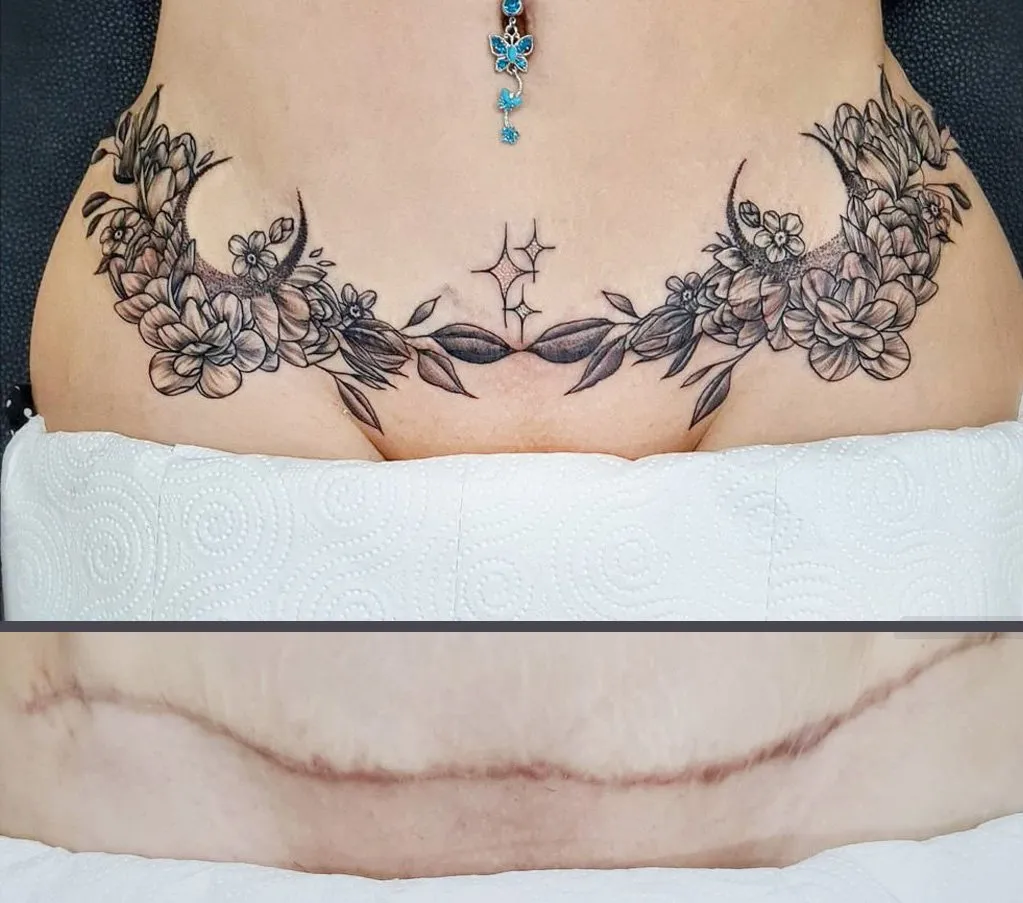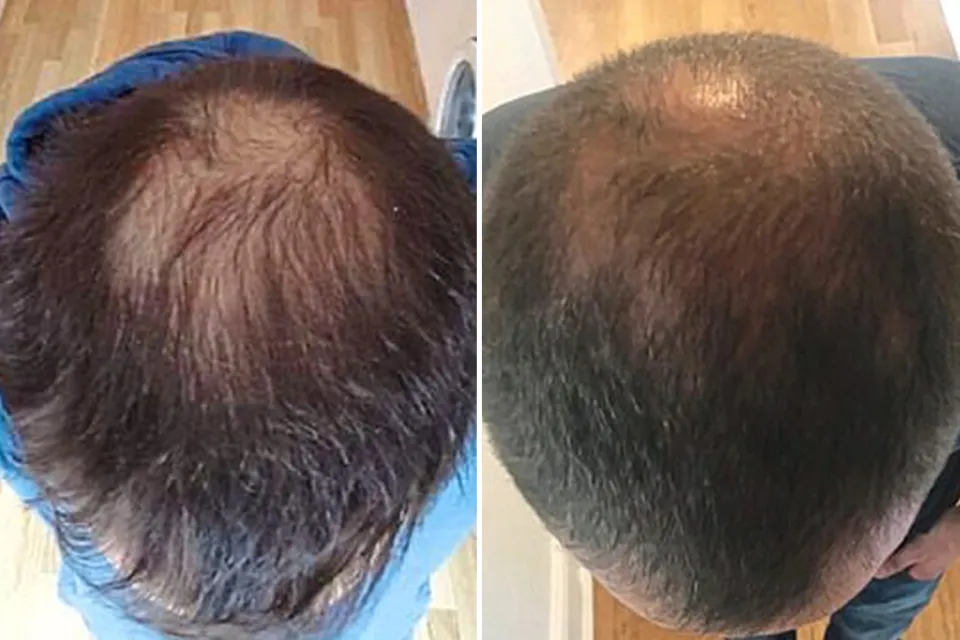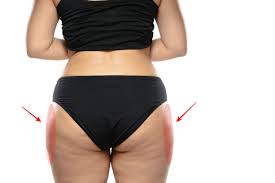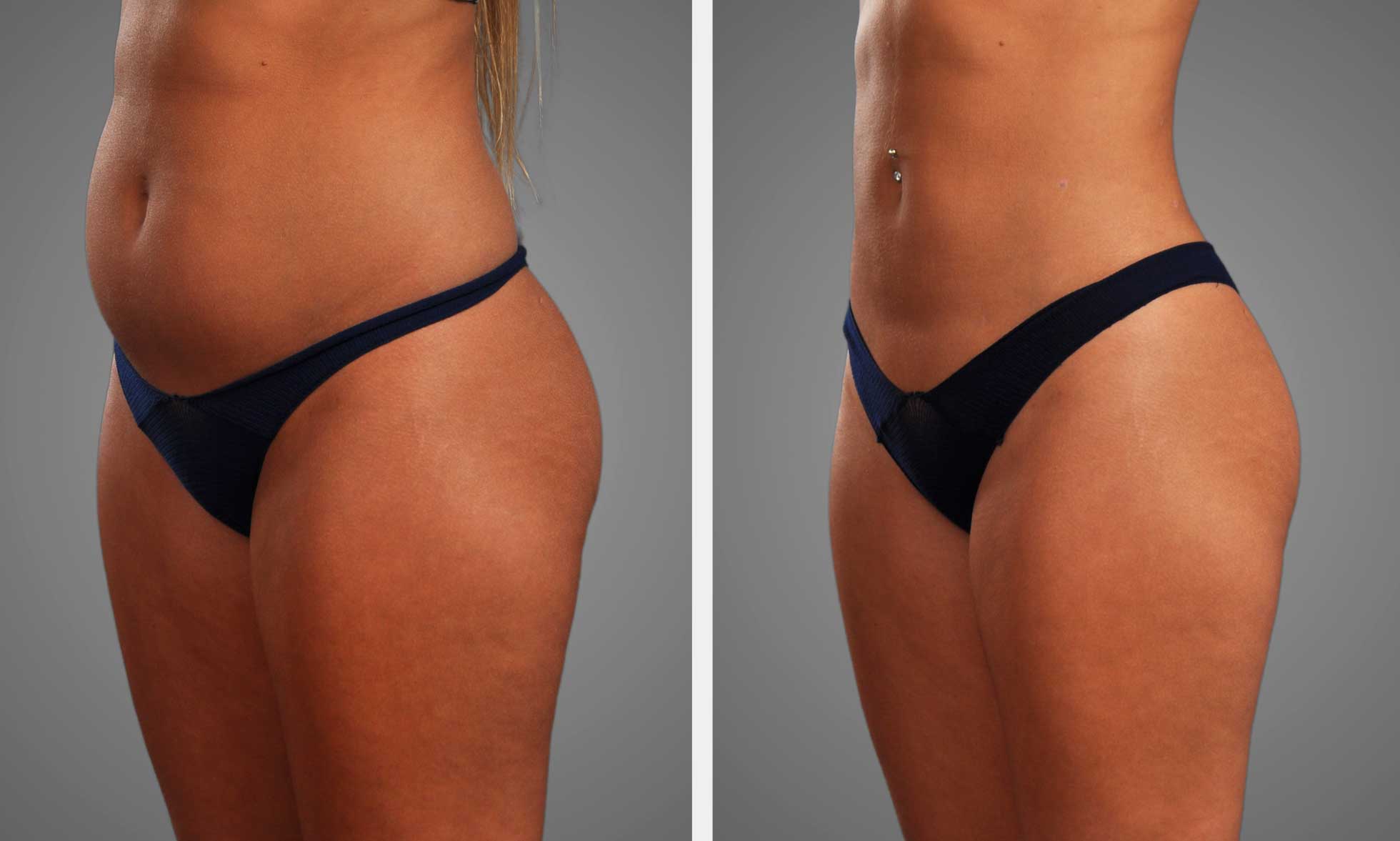Identifying Symptoms of Cellulite
Soft Cellulite
t cellulite often appears as a saggy texture on the skin. It’s more visible when the skin is not taut and can look like loose skin. This type usually affects larger areas and might feel softer to the touch.
People can spot soft cellulite by its puffy appearance. It often makes the skin seem uneven and lacks firmness.
Dimpling Effect
The hallmark of cellulite is its dimpling effect, resembling cottage cheese or orange peel. This texture results from fat pushing against connective tissue beneath the skin.
Dimpling can range from mild — only visible when pinching the skin — to severe, with noticeable rumpling under normal conditions.
Common Areas
Cellulite doesn’t discriminate by body size but tends to appear in certain areas. These include the thighs, buttocks, breasts, lower abdomen, and upper arms.
The back of thighs is a frequent complaint area. Here, cellulite lines create an uneven appearance that many seek to smooth out.
Consulting a Doctor for Cellulite
Medical Advice
Seeking medical advice becomes crucial when cellulite on the back of the thighs affects your mental well-being or physical health. It’s advisable to consult a dermatologist who specializes in skin conditions. They can assess whether your cellulite is typical or if it signals an underlying health issue.
A sudden appearance or rapid worsening of cellulite warrants a doctor’s visit. This could indicate changes in subcutaneous fat distribution or other health concerns. Your doctor can provide insights into why these changes are happening.
Treatment Options
When discussing cellulite with a healthcare provider, inquire about the latest treatments that might suit your case. Advances in medical procedures have made it possible to reduce the appearance of cellulite more effectively than ever before.
Options may include laser treatment, which targets fat cells beneath the skin to smooth out the texture. Another option is massage therapies designed to improve lymphatic drainage, potentially reducing cellulite by eliminating excess fluid and unwanted fat.
Underlying Conditions
Exploring potential underlying health issues is essential. In some cases, rapid cellulite development could be linked to hormonal imbalances or compromised lymphatic systems. Understanding these factors can help tailor treatment plans that address more than just the surface appearance of cellulite.
Doctors might also recommend lifestyle changes such as diet adjustments and exercise to manage body fat levels better and improve overall skin texture.
Unveiling Causes of Cellulite
Fat Accumulation
Excess fat plays a pivotal role in the appearance of cellulite. It pushes against the skin, while fibrous connective cords pull it down. This tug-of-war creates the uneven surface or dimpling known as cellulite. Notably, this can happen regardless of one’s weight, affecting both thin and overweight individuals.
Fat buildup beneath the skin is more visible in areas with less muscle tone. Hence, strengthening these areas through exercise might reduce cellulite visibility.
Hormonal Factors
Hormones significantly influence cellulite formation. Estrogen, insulin, noradrenaline, thyroid hormones, and prolactin all affect fat distribution and breakdown. As estrogen levels decrease with age, blood flow to connective tissue also reduces. This leads to lower collagen production, making skin less elastic and more prone to cellulite.
Genetic Makeup
Your genes may predispose you to characteristics associated with cellulite, such as slow metabolism, fat distribution patterns, and circulatory levels. If your family members have cellulite, you’re more likely to develop it too.
Lifestyle Choices
Lifestyle factors heavily impact cellulite presence. A sedentary lifestyle can lead to weight gain and reduced muscle mass, exacerbating cellulite appearance. Conversely, regular physical activity and a balanced diet can help manage body weight and improve muscle tone, potentially reducing cellulite severity.
Understanding Risk Factors
Fat Distribution
Many people find that cellulite appears more frequently in women. This is due to fat distribution patterns. Women tend to accumulate fat on their thighs, hips, and buttocks.
Research shows these areas are prone to cellulite. The way fat is distributed in the body plays a big role.
Aging Process
As people age, their skin loses elasticity. This loss makes cellulite more visible. Studies link aging with an increase in cellulite visibility.
The skin’s ability to bounce back decreases over time. This fact highlights the impact of aging on cellulite development.
Genetic Factors
Genetics also determine cellulite risk. Some individuals are more predisposed due to their family history.
Evidence suggests a strong genetic component. If your family members have cellulite, you might be more likely to develop it too.
Lifestyle Choices
Lifestyle choices significantly affect cellulite development. Inactivity, for instance, can lead to increased fat accumulation and worsen cellulite.
Pregnancy is another factor that can change the body’s fat distribution. These changes can make cellulite more apparent in certain parts of the body.
Effective Cellulite Reduction Methods
Home Remedies
Home remedies often serve as the first line of defense against cellulite. Hydration and a balanced diet can improve skin elasticity. Regular exercise aids in toning the muscles beneath the cellulite, making it less visible.
Massage techniques also play a role. They increase blood flow and may break down fat cells under the skin.
Topical Treatments
Many seek topical solutions for convenience and ease of use. Creams containing caffeine or retinol have shown promise in reducing cellulite appearance. Consistent application is key to seeing results over time.
Radiofrequency
Radiofrequency treatments stand out for their effectiveness. This non-invasive method uses energy waves to heat the dermis, promoting collagen production. It leads to tighter skin and a noticeable reduction in cellulite.
Patients often see improvement after several sessions.
Vacuum Therapy
Vacuum therapy offers another non-surgical option. This procedure involves suction and massage to boost lymphatic drainage and blood circulation. It can lead to temporary smoothing of dimpled skin.
Laser Treatment
Laser treatment targets cellulite with concentrated light beams. It’s more invasive but delivers longer-lasting results by breaking down fat cells and stimulating collagen growth.
Multiple sessions are typically required for optimal outcomes.
Dietary Changes for Cellulite Management
Antioxidant Foods
Incorporating foods rich in antioxidants can significantly impact skin health. These nutrients fight free radicals, reducing inflammation and improving the skin’s appearance. Berries, green tea, and dark leafy greens are excellent choices.
Eating omega-3 fatty acid-rich foods like salmon and avocados also supports skin health. They help make the skin look smoother and less prone to cellulite.
Processed Foods
Reducing processed foods is crucial in managing cellulite. Processed items and sugars lead to fat accumulation beneath the skin, exacerbating cellulite appearance. Opt for whole foods instead.
Limiting sugar intake is another effective strategy. It not only helps with weight management but also reduces the risk of developing more cellulite.
Hydration
Staying hydrated plays a key role in maintaining skin elasticity. Drink plenty of water throughout the day to keep your skin hydrated and possibly reduce cellulite visibility.
Water flushes toxins out of the body, which might contribute to a smoother skin texture over time.

Exercise Strategies for Smoother Thighs
Strength Training
Strength training exercises focus on the thighs, buttocks, and legs. They are key in improving muscle tone and reducing fat in these areas. Squats and lunges are effective for targeting these specific parts of the body. Incorporating weights can intensify the workout, challenging the muscles more and promoting growth.
Regular strength training increases muscle mass. This change can diminish the appearance of cellulite by providing a firmer foundation under the skin.
Cardio Workouts
Cardiovascular workouts are essential for burning fat and boosting circulation. Activities like running, cycling, and brisk walking target fat loss throughout the body, including the thighs. A study suggests that regular physical activity improves blood flow to these areas, potentially reducing cellulite visibility.
Incorporating cardio into your routine several times a week can lead to noticeable improvements over time.
Yoga and Pilates
Yoga and Pilates enhance flexibility, tighten skin, and improve overall body composition. These activities focus on core strength, balance, and stability. They also promote mental well-being which is crucial in managing stress levels that can affect skin appearance.
Practicing yoga or Pilates regularly can lead to smoother thighs by tightening loose skin and improving posture.
Hydration and Collagen’s Role
Stay Hydrated
Hydration plays a key role in keeping the skin elastic. Drinking enough water maintains the skin’s moisture and can help reduce the appearance of cellulite. It flushes out toxins that can accumulate and lead to fat deposits.
Staying hydrated improves blood flow. This, in turn, helps nourish the skin cells, making them look firm and healthy. Aim for at least 8 glasses of water a day.
Boost Collagen
Collagen strengthens the skin’s connective tissue. This makes the skin look smoother and firmer. Foods rich in vitamin C or supplements can boost collagen production. They repair and renew skin cells.
Consider using lotions that contain seed extract or other ingredients known to improve collagen levels. These products can penetrate the skin, offering a direct boost to collagen synthesis.
Summary
Cellulite on the back of your thighs can be a source of discomfort, but understanding its causes, risk factors, and effective management strategies empowers you to tackle it head-on. From making informed dietary changes to incorporating specific exercises and staying hydrated, your journey towards smoother thighs is well within reach. Each step you take, guided by professional advice and a commitment to your health, brings you closer to your goal.
Now’s the time to put this knowledge into action. Start by assessing your lifestyle and identifying areas for improvement. Whether it’s adjusting your diet, ramping up your exercise routine, or simply drinking more water, each change contributes to your overall well-being and gets you one step closer to reducing the appearance of cellulite. Remember, consistency is key. Embrace these strategies with confidence and patience, and watch as your efforts pay off. Let’s get moving!
Frequently Asked Questions
How can I identify cellulite on my thighs?
Cellulite appears as dimpled or bumpy skin, often described as having a cottage cheese texture. It’s most common on the thighs and buttocks.
What causes cellulite to form on the back of my thighs?
Cellulite forms due to fat deposits pushing through connective tissue beneath the skin, often influenced by factors like genetics, diet, and lifestyle.
Should I consult a doctor for cellulite?
Consulting a doctor is advisable if cellulite is accompanied by discomfort or you’re seeking medical treatments. They can provide personalized advice and treatment options.
Are there effective methods to reduce cellulite?
Yes, treatments ranging from topical creams to laser therapy have been shown to reduce cellulite appearance. Consistency and a holistic approach are key.
Can changing my diet help manage cellulite?
Absolutely. A balanced diet rich in fruits, vegetables, and hydration can improve skin elasticity and reduce the appearance of cellulite.
How does exercise contribute to smoother thighs?
Regular exercise, especially strength training and cardio, can tone muscles and reduce overall body fat, making cellulite less noticeable.
What role does hydration play in managing cellulite?
Staying hydrated improves skin elasticity and can help minimize the appearance of cellulite by keeping the connective tissue healthy and flexible.
















































